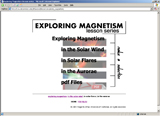Exploring Magnetism
The Exploring Magnetism unit contains sequential lessons on magnetism that inspire students to learn how electricity and magnetism are connected and to apply their knowledge. The goal is for students to develop a deeper understanding of electromagnetism through inquiry and hands-on activities. The first two sessions form the basic lessons called Exploring Magnetism and the third session, named Exploring Magnetism in the Solar Wind, explores magnetism in the Solar Wind being studied by the STEREO-IMPACT mission.
Key Questions
1. How does a compass operate?
2. What is magnetism and where do we see evidence of it on Earth and in space?
3. How do we measure magnetism?
4. What is the relationship between electricity and magnetism?
5. What do scientists use to measure magnetism in space?
Learning Objectives
Session 1
1. Students will know that magnets have an invisible force field known as a magnetic field.
2. Students will be able to detect and draw a magnetic field using compasses.
3. Students will know that a compass is made up of a tiny bar magnet that aligns itself with a large magnetic field.
4. Students will know that bar magnets have two poles and that similar poles repel each other and differing poles attract each other.
Session 2
1. Students will know that the Earth has a magnetic field and it acts almost like a bar magnet.
2. Students will know that electricity flowing in wires creates an invisible magnetic field.
3. Students will be able to use magnetic compasses to explore the magnetic fields in their world.
4. Students will understand the relationship between magnetic and electrical fields known as electromagnetism.
Session 3
1. Students will know the concept of Interplanetary Magnetic Fields (IMF).
2. Students will know why a magnetometer boom is needed on a spacecraft studying IMF.
3. Students will be able to use their knowledge of magnets, magnetic fields, and electromagnetism to create a real world instrument used to measure magnetic fields from a NASA satellite.
4. Students will use real world engineering techniques to create a practical and functioning NASA satellite that can study and accurately measure IMF.
General Subject Areas
Astronomy, Physics, Earth Science
|
 Author: CSE @ SSL
Author: CSE @ SSL
VIEW THE LESSON
Student Activities
The goal of this unit is for students to develop a deeper understanding of electromagnetism through inquiry based activities. The first session in the guide is designed to teach students that magnets have an invisible force field known as a magnetic field, and that this field has an effect that can be measured around a magnet using a compass. The second session is designed to teach students that electricity flowing in wires also creates an invisible magnetic field that can also be measured using a compass. Students will learn that the larger the current the stronger the magnetic field and that moving magnets across wires creates an electric current. The third Session is designed so students can apply their knowledge of magnetic fields to the engineering problem of designing a spacecraft to measure small interplanetary magnetic fields.
Student Prerequisites
Students should know the concept of the atom and positive and negative charges.
Assessment
Session 1 worksheets (pdf)
Session 1 rubric (pdf)
Session 2 worksheets (pdf)
Session 2 rubric (pdf)
Session 3 worksheets (pdf)
Session 3 rubric (pdf)
Extended Learning
N/A
|
Time Requirements
Each session requires approximately 90 mintues for preperation and each activity takesapproximately one hour.
Materials Required
-Browser enabled computers with Internet connection.
-Copies of student worksheets
-Student materials for activities (detailed in lesson)
Required Plugins
N/A
Additional Resources
N/A
Best For Grades
elementary/middle school
National Science Education Standards (NSES)
grades 5-8
grades 9-12
State Science Standards
Grade 4 Physical Sciences
Grade 5 Physical Sciences
Grade 8 Physical Science
Grades 9-12 Earth Sciences
Grades 9-12 Physics
Have a science question? Visit our Ask an Expert page. Email questions or comments about SEGway resources to: outreach@ssl.berkeley.edu
|












